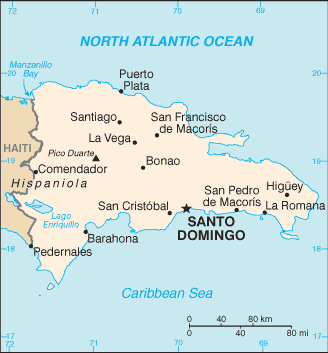Welcome to the Virtual Education Wiki ~ Open Education Wiki
Dominican Republic
Not to be confused with Dominica.
Partners situated in Dominican Republic
None.
Dominican Republic in a nutshell
(sourced from http://en.wikipedia.org/wiki/Dominican_Republic)

The Dominican Republic (Spanish: República Dominicana) is a nation on the island of Hispaniola, part of the Greater Antilles archipelago in the Caribbean region. The western third of the island is occupied by the nation of Haiti, making Hispaniola one of two Caribbean islands that are occupied by two countries, Saint Martin being the other.
Both by area and population, the Dominican Republic is the second largest Caribbean nation (after Cuba), with 48,442 km² and an estimated 10 million people.
The capital is Santo Domingo.
The Dominican Republic is a representative democracy, with national powers divided among independent executive, legislative, and judicial branches. The President of the Dominican Republic appoints the Cabinet, executes laws passed by the Congress, and is commander in chief of the armed forces. The president and vice president run for office on the same ticket and are elected by direct vote for 4–year terms. Legislative power is exercised by a bicameral Congress composed of the Senate (with 32 members) and the Chamber of Deputies (with 178 members).
The Dominican Republic is divided into 31 provinces. Additionally, the national capital, Distrito Nacional (National District), is contained within Santo Domingo. The provinces are divided into municipalities (municipios; singular municipio). They are the second–level political and administrative subdivisions of the country.
The population of the Dominican Republic in 2007 was estimated by the United Nations at 9,760,000, which placed it number 82 in population among the 193 nations of the world. In that year approximately 5% of the population was over 65 years of age, while 35% of the population was under 15 years of age. There were 103 males for every 100 females in the country in 2007. According to the UN, the annual population growth rate for 2006–2007 is 1.5%, with the projected population for the year 2015 at 10,121,000.
Dominican Republic education policy
http://www.seescyt.gov.do/default.aspx (Spanish)
Which is responsible to promote, regulate and manage the National System of Higher Education, Science and Technology under Law 139-01.
http://www.adru.org/ (Spanish)
It was founded on 18 August 1980 as a non-profit association composed of state and private universities Dominican recognized by existing laws, whose legal status was granted by Decree No. 2548 dated 3 July 1981.
Dominican Republic education system
Higher education
Universities in Dominican Republic
For a list of universities see http://en.wikipedia.org/wiki/List_of_universities_in_the_Dominican_Republic
Polytechnics in Dominican Republic
Higher education reform
The Bologna Process
Administration and finance
Quality assurance
Dominican Republic's HEIs in the information society
Towards the information society
Information society strategy
Virtual Campuses in HE
Interesting Virtual Campus Initiatives
Interesting Programmes
See Open University for Adults.
Re.ViCa Case-study
None.